Se você estiver configurando qualquer sistema de som surround, provavelmente encontrará números como 2.1, 5.1, 7.1, 7.1.2, 9.1 e até além deles! Você pode estar se perguntando o que são esses números estranhos e o que eles significam para o seu sistema de home theater.
Bem, esses números são muito importantes, pois descrevem a configuração dos alto-falantes do sistema e, em alguns casos, o formato do sinal de áudio que está sendo entregue. Eles também são importantes ao considerar se o som surround vale a pena para você.
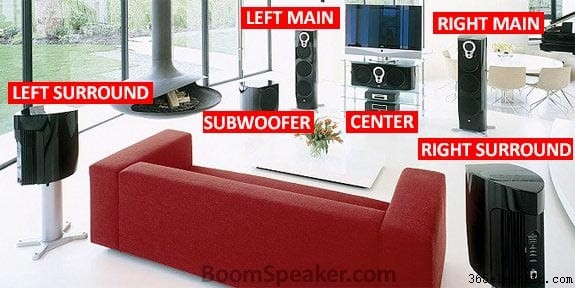
Então, vamos entrar rapidamente nos detalhes desses diferentes sistemas de alto-falantes de som surround e como seus vários sistemas de canais são configurados.
Observe que, se você estiver procurando por um sistema de áudio sem fio para sua casa, um sistema multiroom sem fio como Sonos ou Heos é uma escolha melhor. Você pode conferir nossa análise de Sonos vs Heos.
O que os números significam na terminologia de som surround?
O primeiro número (ex:o "5" em 5.1)
O primeiro número de uma configuração de sistema de alto-falantes indica o número de alto-falantes principais na configuração de som surround. Quando falamos de alto-falantes principais, estamos nos referindo ao centro, frontal esquerdo, frontal direito e outros vários alto-falantes surround.

Os sistemas surround modernos normalmente terão de pelo menos 2 a 9 ou até mais alto-falantes principais.
O segundo número (ex:o “1” em 5.1)
O segundo número de uma configuração do sistema de alto-falantes indica o número de subwoofers na configuração. Na maioria dos casos, esse número será 1, o que significa que o sistema possui um único sub.

No entanto, algumas configurações adicionam um sub adicional para obter um baixo mais completo em seu home theater e, portanto, você verá o número 2, por exemplo, 7.2.
O terceiro número (ex:o "2" em 7.1.2)
O terceiro número de uma configuração de sistema de alto-falantes é visto com menos frequência e refere-se a alto-falantes de altura. Essa configuração indica o número de alto-falantes de "altura" ou "disparo para cima". 
Os alto-falantes de altura são alto-falantes de som surround adicionais que normalmente são colocados no teto, na frente do home theater. Esses alto-falantes adicionam a dimensão da altura ao campo de som surround para criar um efeito tridimensional.
Para esses alto-falantes, o teto não deve ser superior a 14 pés, mas deve estar pelo menos três pés diretamente acima do alto-falante frontal esquerdo e direito e voltado diretamente para o ouvinte.
Na maioria dos casos, a maioria das pessoas terá dois alto-falantes voltados para cima e, portanto, esse terceiro número geralmente é 2.
Sistemas de som surround de home theater explicados:2.0 a 13.1
Sistema de alto-falante estéreo 2.0
Os sistemas de alto-falante 2.0 são estéreos normais, não som surround. Estes são os sistemas estéreo mais básicos que você encontrará por aí. Na verdade, você pode conferir nosso guia sobre como converter estéreo em som surround 5.1.
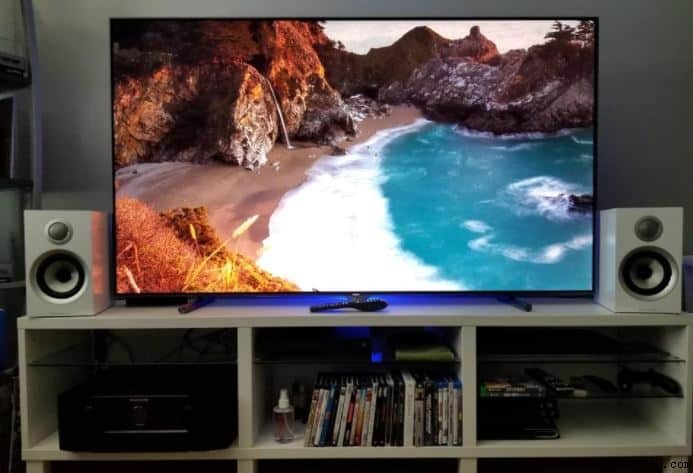
Esses estéreos têm som estéreo 2.0 direito e esquerdo com dois canais distintos. Eles são compostos por um simples canal esquerdo e direito (ou um alto-falante esquerdo e direito).
Dizemos que eles são básicos porque são exatamente como seus antigos sistemas de som. Eles usam dois canais de alto-falante para separar os sons para criar uma experiência mais completa.
A maioria dos dispositivos de música dedicados feitos hoje em dia, de rádios básicos a boomboxes, terão pelo menos som estéreo e, portanto, podem ser classificados como sistemas de som surround 2.0.
A vantagem número um de uma configuração 2.0 é que é uma configuração acessível. Muitas pessoas começam seus home theaters dessa maneira, pois é barato e simples.
Configuração do sistema de alto-falantes de som surround 2.0
Na maioria dos casos, quando as pessoas configuram um sistema de alto-falantes 2.0, eles terão dois alto-falantes ao lado da televisão – um à esquerda e outro à direita.
Na maioria dos casos também, esses alto-falantes serão alimentados por um receptor AV ou um amplificador. Nas configurações mais simples, a maioria das pessoas optará por alto-falantes ativos que não precisam de uma fonte de alimentação separada para manter a configuração simples e funcional.
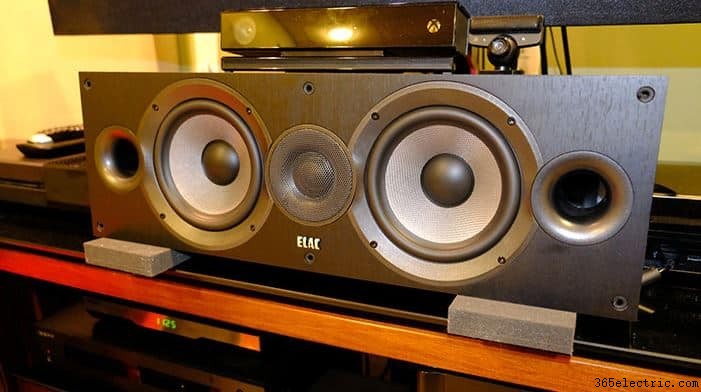
Uma desvantagem dos sistemas 2.0 é que eles não possuem um subwoofer separado e, portanto, a qualidade dos graves pode estar faltando, a menos que você obtenha alguns bons alto-falantes amplificados.
Como esse sistema se concentra no som na frente, também não há alto-falantes ao redor, portanto, a configuração 2.0 ainda é bastante básica. Novamente, você pode conferir nosso guia sobre como converter áudio estéreo 2.0 em sistemas de som surround 5.1.
Uma consideração importante para esses sistemas simples é garantir que seus alto-falantes sejam compatíveis com todos os seus dispositivos, desde a TV de turismo até o smartphone, e tenham capacidade sem fio, incluindo Bluetooth.
Sistema de alto-falantes de som surround 2.1
A configuração do sistema de alto-falantes 2.1 é um avanço da configuração 2.0. Nesta configuração, você tem os alto-falantes esquerdo e direito e um subwoofer.
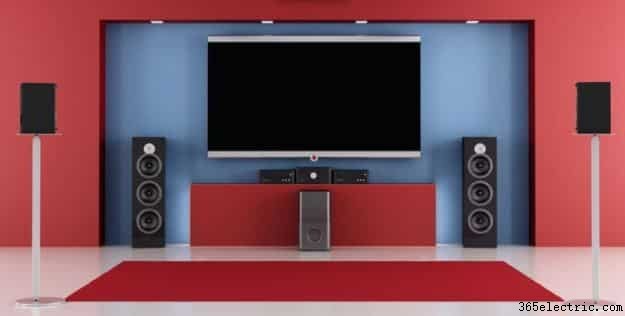
Ao ter um subwoofer na configuração, seu sistema surround fornecerá melhores graves.
Configuração do sistema de alto-falantes de som surround 2.1
A configuração 2.1 será semelhante à configuração 2.1 com cada alto-falante em cada lado da televisão. O subwoofer normalmente será colocado no canto da parede.
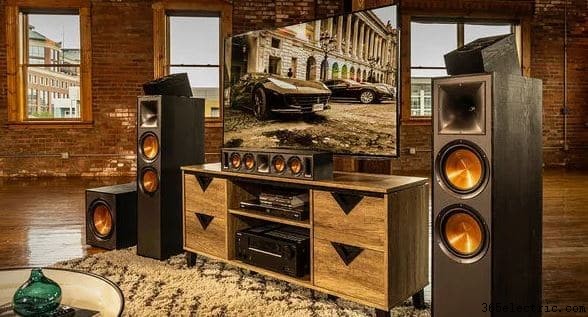
No entanto, isso realmente depende, pois cada sala é diferente, você deve mover o subwoofer para obter o efeito de graves completo. Na verdade, muitas pessoas descobriram que o melhor posicionamento para o subwoofer é atrás do sofá.
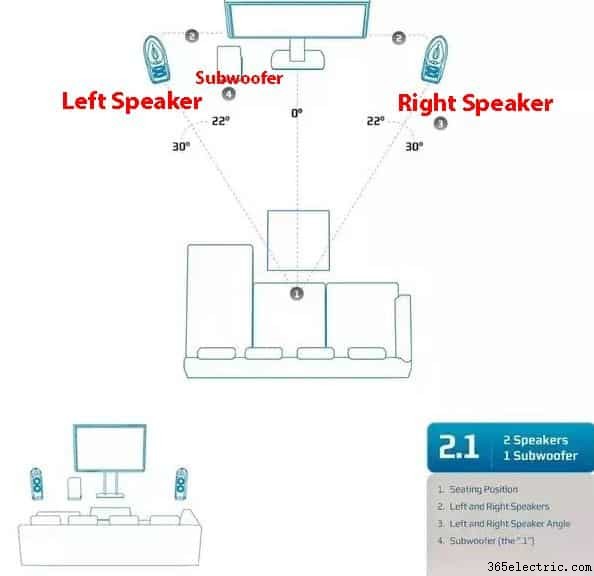
Muitas pessoas hoje em dia optam por uma barra de som de 2.1 canais para obter o subwoofer 2.1 na configuração. Essa configuração é ótima para qualquer home theater se você não tiver fundos para dispositivos adicionais. Na verdade,
recomendamos usar pelo menos uma configuração 2.1 em seu home theater .
Sistema de alto-falantes de som surround 3.1
Um sistema de som 3.1 é um sistema de som de quatro canais. Esta configuração tem três alto-falantes principais e um subwoofer.
Isso significa que o sistema consistirá em um alto-falante esquerdo, central e direito.
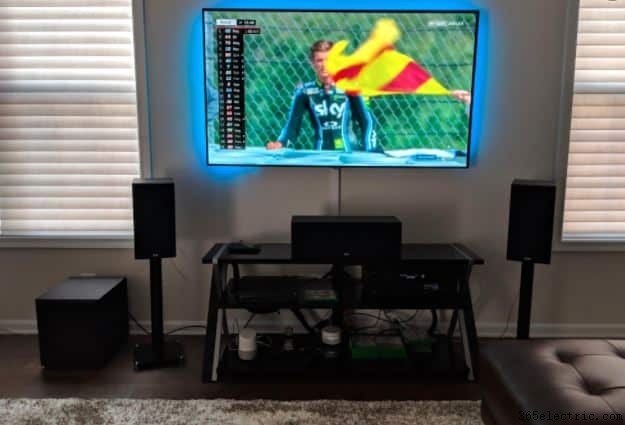
Com 3.1, você terá um alto-falante central adicional sobre a configuração 2.1. Este alto-falante central separa o diálogo de áudio que foi processado para um canal distinto. No entanto, os canais esquerdo e direito permanecem distintos.
Assim, enquanto os alto-falantes centrais reproduzem o diálogo, os alto-falantes esquerdo e direito serão usados para efeitos, música e outros sons estéreo.
3.1 Configuração do sistema de alto-falantes de som surround
Com a configuração 3.1, os alto-falantes esquerdo e direito são normalmente posicionados na lateral da TV com o alto-falante central em cima ou embaixo da TV, e o subwoofer também fica normalmente posicionado no chão no centro da configuração.
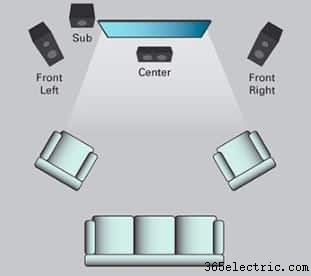
Os sistemas 3.1 ainda são relativamente simples e não possuem alto-falantes ao redor. No entanto, a adição do alto-falante central faz um bom trabalho para aprimorar o som cinematográfico.
A configuração 3.1 é muito popular em algumas barras de som. Essas barras de som têm três alto-falantes ou uma barra na frente e até um subwoofer embutido. Outros podem ter o sub separado.
Sistema de alto-falantes de som surround 4.1
O sistema de som surround 4.1 home theater é um avanço do sistema de alto-falantes 3.1. É uma configuração muito comum e inclui o seguinte:
- frente esquerda e frente direita
- traseira esquerda e traseira direita
- um subwoofer.
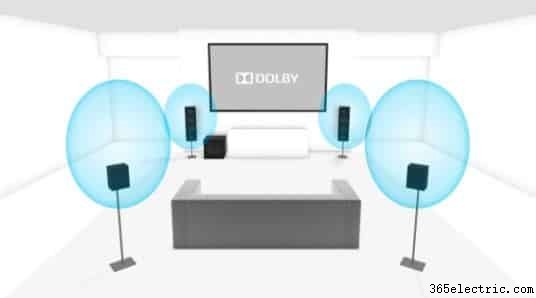
Isso significa que esta é uma configuração de cinco canais, exceto que não inclui o alto-falante do canal central típico.
Sistema de alto-falantes de som surround 5.1
O sistema de home theater 5.1 é o sistema de home theater mais popular que existe. Oferecendo um verdadeiro som surround, esta configuração de home theater tornou-se a referência para o som surround de home theater.
Por que o sistema de som surround 5.1 é popular?
Você verá o sistema de som surround 5.1 mencionado com bastante frequência quando estiver pesquisando ou navegando em produtos de home theater. Veja por que a configuração de alto-falante 5.1 é tão popular:
- Simples: É o sistema de som surround verdadeiro mais simples
- Áudio imersivo: Essa configuração oferece uma experiência de áudio muito mais imersiva do que qualquer estéreo regular de dois ou três canais.
- Considerações de espaço: É ótimo para espaços menores. Um sistema surround 5.1 é bom o suficiente para som surround, mas inclui apenas 5 alto-falantes e um sub. Isso é bom para espaços menores, uma vez que você sabe como colocá-los. Confira nosso artigo sobre como configurar alto-falantes 5.1 em uma sala pequena.
- Conectividade: As configurações surround 5.1 são muito populares e oferecem uma ampla gama de opções de conexão. Por exemplo, alguns sistemas 5.1 podem até se conectar a um telefone celular. Como exemplo, confira este guia sobre como conectar seus alto-falantes Philips 5.1 ao seu celular.
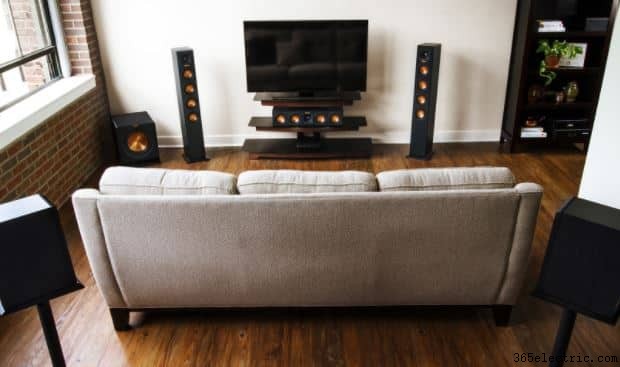
Você encontrará sistemas de home theater de todas as formas e tamanhos usando a configuração do sistema surround 5.1 para criar uma excelente experiência de áudio.
5.1 Configuração do sistema de alto-falantes
A configuração do sistema de alto-falantes 5.1 é bastante simples. Possui seis canais, que incluem cinco alto-falantes principais e, claro, um subwoofer.
Aqui está a configuração típica:
- Orador principal: O sistema normalmente tem três alto-falantes na frente com um à esquerda, um no centro e um à direita da TV.
- Subwoofer: o sub é normalmente colocado no meio ou nos cantos da sala.
- Altifalantes de som surround: Há também dois alto-falantes de som surround que normalmente são colocados na parte de trás da sala – normalmente em ambos os lados do sofá – um à esquerda e outro à direita. Esses alto-falantes também são chamados de alto-falantes satélites. Eles são diferentes dos alto-falantes de estante típicos com os quais você pode estar familiarizado. Se você não estiver ciente da diferença, confira nosso artigo sobre alto-falantes de estante versus satélite.
Observe, no entanto, que esta é apenas a configuração mais comum, o sistema de alto-falantes 5.1 é bastante versátil e pode ser configurado de várias maneiras, dependendo das necessidades exclusivas da sua sala de home theater.
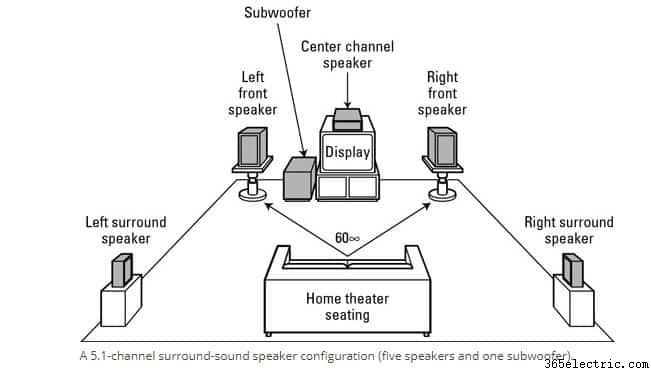
No entanto, se você tiver espaço suficiente em seu home theater, a configuração ideal é a seguinte:
Colunas frontais: Os alto-falantes frontais esquerdo e direito em um ângulo de 22-30 graus do alto-falante central/TV
Subwoofer: Idealmente, você deve colocar o sub no meio do chão ou em um dos cantos. Você pode até colocar o submarino atrás do sofá se quiser o efeito de vibração. No entanto, com subs, é melhor movê-lo até obter o melhor desempenho de graves.
Alto-falantes surround: Os alto-falantes de som surround devem ser colocados em um ângulo de 90-110 graus do alto-falante central/TV.
O sistema de alto-falantes 5.1 é tão popular que você achará essa configuração compatível com muitos tipos de dispositivos.
Na verdade, muitos laptops e computadores de mesa vêm com uma placa de som 5.1 e, portanto, podem ser usados com esses dispositivos, bem como com qualquer coisa, desde DVDs comuns até cinemas e smart TVs digitais.
Sistema de alto-falantes de som surround 6.1
A configuração de som surround de home theater 6.1 está um pouco acima da configuração 5.1.
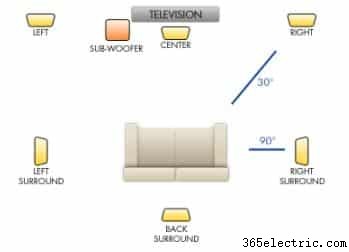
Na verdade, é como um sistema surround 5.1, mas inclui um alto-falante adicional. Este alto-falante ajuda a criar uma experiência de som mais completa e definitivamente mais realista.
Aqui está a configuração:
- Tudo está configurado como o sistema 5.1
- Há um alto-falante adicional que normalmente é colocado na parte traseira central do home theater
A ideia da configuração 6.1 é adicionar uma dimensão de som adicional à sua configuração de home theater sem ter que usar uma configuração completa de som surround 7.1.
Esta é uma ótima ideia se você estiver procurando por esse efeito adicional, mas estiver com pouco orçamento. Você pode adicionar outro alto-falante traseiro mais tarde, se necessário, para concluir a configuração 7.1 abaixo.
Sistemas de som surround 7.1 e 7.1.2
Sistema de som surround 7.1
A configuração de alto-falante 7.1 é o próximo passo do sistema de alto-falante 6.1. Isso significa que inclui todos os componentes de um sistema de alto-falantes de 5.1 canais normal, mas também inclui dois alto-falantes traseiros, um a mais que o sistema 6.1.
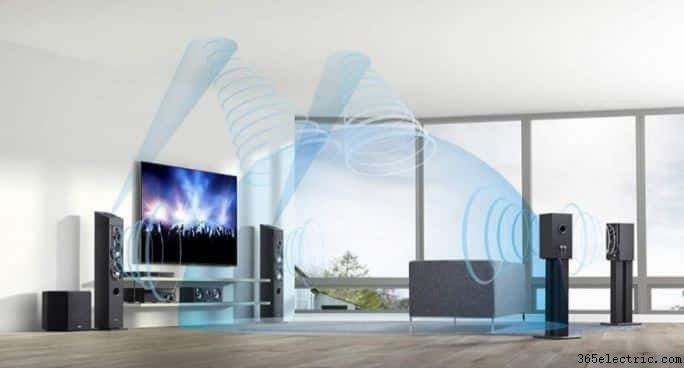
These two rear speakers deliver surround sound which means that the two sides surround speakers won’t be responsible for both rear and surround sound unlike in 5.1 systems.
This gives an even more full, rounded sound experience to complete that surround sound cinematic effect. This makes it an eight-channel speaker system and is quite common.
7.1 Speaker System Setup
The 7.1 speaker system is similar to the 5.1 as mentioned before. In fact, the setup is the same except for the addition of two rear speakers. H
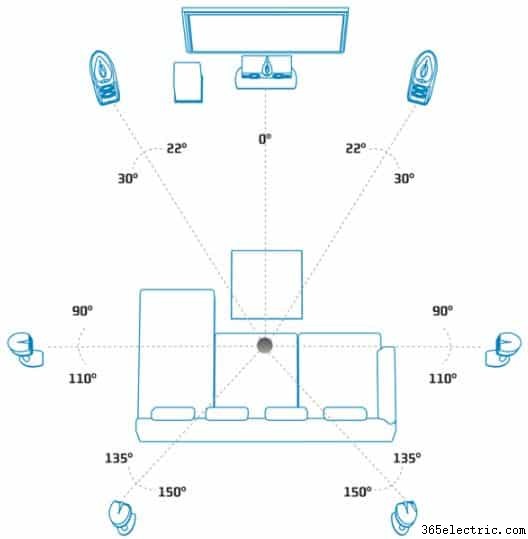
In general, the two additional rear speakers should ideally be placed at a 135 to a 150-degree angle from the center channel/TV. This ensures that you will achieve the best ad most optimal surround sound experience by amplifying background sounds. These are also satellite speakers. Remember, these are different from say bookshelf speakers (check out satellite vs bookshelf speakers).
You can get a better idea as to what this means by checking our our guide on surround vs surround back speakers.
7.1.2 Surround Sound System
Remember above we explained that the last number refers to the number of ‘height’ speakers?So what are height speakers?
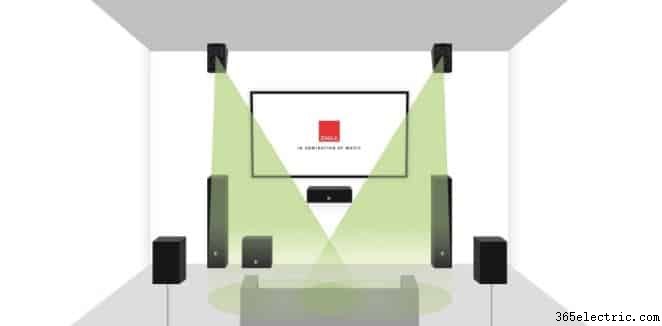
Height speakers are additional surround sound speakers that are normally placed on the ceiling at the front of the home theater.These speakers add the dimension of height to the surround sound field to create a three-dimensional effect. So the 7.1.2 speaker system configuration is simply the 7.1 speaker system with 7 speakers and a subwoofer.The system includes the addition of two height speakers which are normally ceiling speakers or up-ward firing Dolby Atmos speakers.
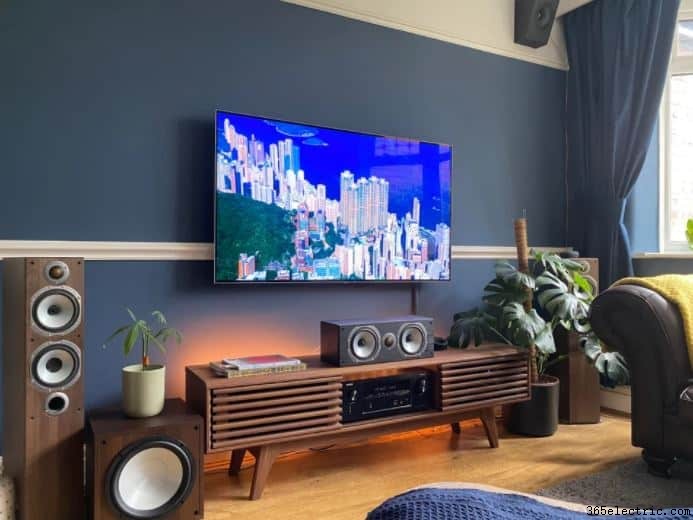
You will find this setup mostly for Dolby Atmos in-ceiling speakers. Dolby Atmos is a surround sound technology that adds the height dimensions to surround sound systems to create that 3D effect in the surround sound field. This type of configuration is for more high-end home theaters as it takes a bit more work and is certainly more expensive than the simpler configurations. However, it’s worth the money because all these speakers work together to provides a top-notch, realistic, and immersive home theater cinematic experience.
7.1.2 Surround Sound System Setup
Firstly, because this system normally includes ceiling speakers, you will find that it is most suited for basic ceilings made of drywall or plaster.
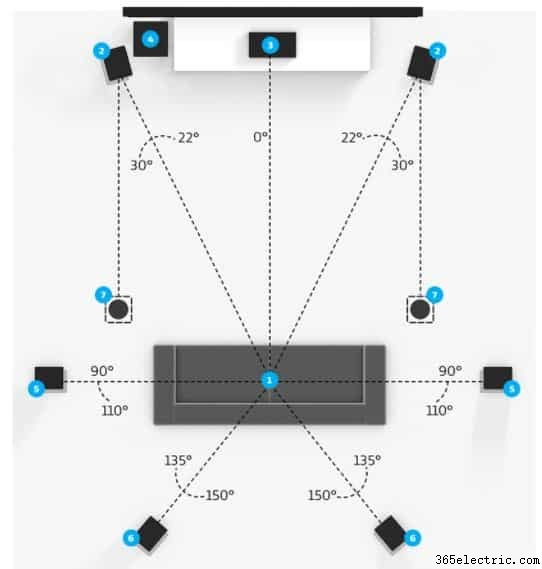
Additionally, the ceiling shouldn’t be higher than 14 feet but should be at least three feet directly above your left and right main front speaker and face the listener directly.
This surround sound configuration is becoming more popular in modern home theaters and does well to create a dome of sound that is like nothing else.
One important consideration however is to ensure that your system is Dolby Atmos compatible if you are using Dolby Atmo upward-firing speakers.
7.2 Surround Sound System
While 5.1 systems are the most popular today, 7.2 surround sound systems are becoming quite popular as well.
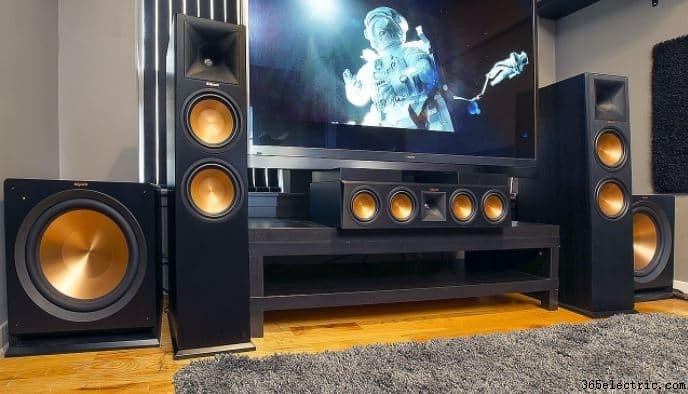
Today, many modern receivers support this surround sound layout. 7.2 surround sound systems are very similar to the 7.1 surround sound setup except that it has an additional subwoofer.
Why do you need two subwoofers?
Well, first of all, you don’t necessarily need two subwoofers. One is fine for most people. However, if you want stronger and more balanced bass, two subwoofers are a great choice.
It’s about creating a better overall bass experience really with excellent bass all around the room. As such, if you are a bass bum, a second subwoofer is a great choice for you.
7.2 Surround Sound System Setup
The 7.2 setup is similar to that of the 7.1 except that there is an additional subwoofer. There are many placement options for your subwoofers to get more bass.
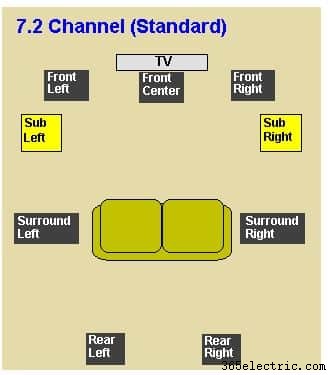
However, the most important consideration initially is that your receiver or amplifier needs to support two subwoofers to support the 7.2 configurations.
9.1 Surround Sound:The Cinematic Experience
Now for the hard-hitting, mega 9.1 home theater surround sound system. The 9.1 home theater surround system is a ten-channel surround sound system that includes nine speakers and a subwoofer.
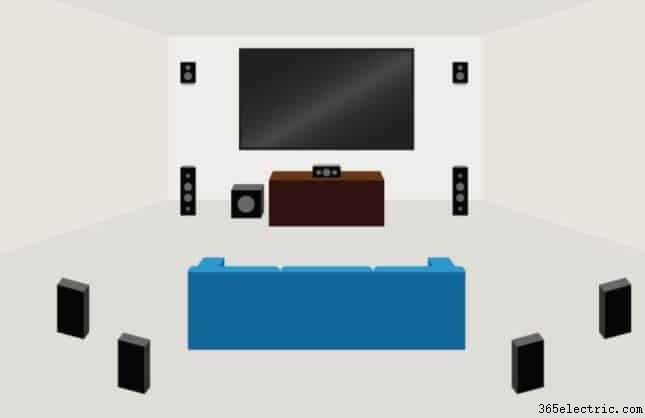
Of course, these systems are quite expensive and are for very high-end home theater surround sound setup for the most discerning of audiophiles or those who crave a completely immersive surround sound experience.
This is why the 9.1 setup is not as common as the 5.1 or 7.1.2 home theater system.
The 9.1 surround system is really the same as the 7.1.2 configuration with the addition of two height speakers.
Remember, the height speakers are Dolby Atmos speakers that are used to add the dimension of height to the surround field to create a 3D surround sound effect.
9.1 Surround Sound System Setup
Setting up a 9.1 home theater system is not extremely complicated, however, each component should be positioned and chosen carefully considering the acoustics of the room and the specs of the audio components.
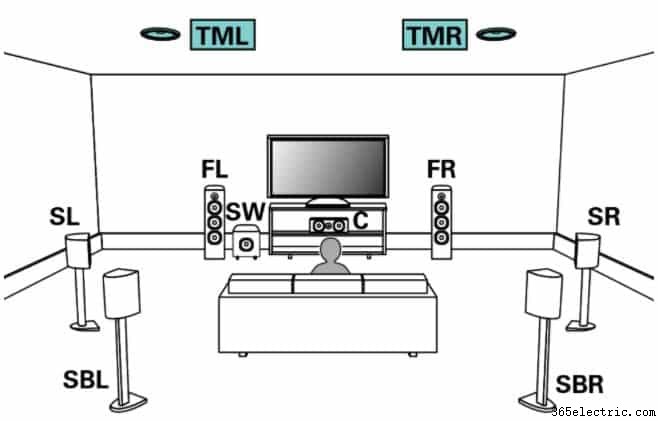
Failing to do so can cause any number of problems This is why setting up such a system requires a professional audio technician. For example, you will need a modern receiver that can handle the 9.1 configuration.
Keep in mind that similar to the 7.1 systems, so the ceiling shouldn’t be higher than 14 feet but should be at least three feet directly above your left and right main front speaker and face the listener directly.
9.1.2 Home Theater Surround System
The 9.1.2 surround sound home theater system is similar to the 9.1 system except that it has two front wide speakers, instead of the two front height speakers.
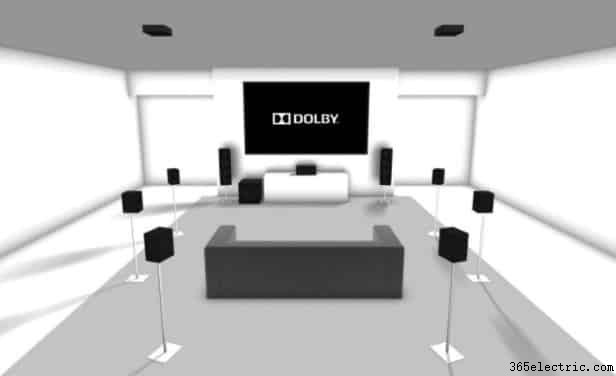
This is in addition to the two ceiling or upward-firing speakers.
If that is confusing, let’s explain further. In the 9.1.2 home theater system, you have a left and right front speaker, a center speaker, a subwoofer, a left and a right front wide speaker, a left and a right surround speaker, a left and a right rear speaker, and a left and a right ceiling speaker.
9.1.2 Surround Sound System Setup
The 9.1.2 configuration setup is to create a fully immersive, high-end dome sound experience.
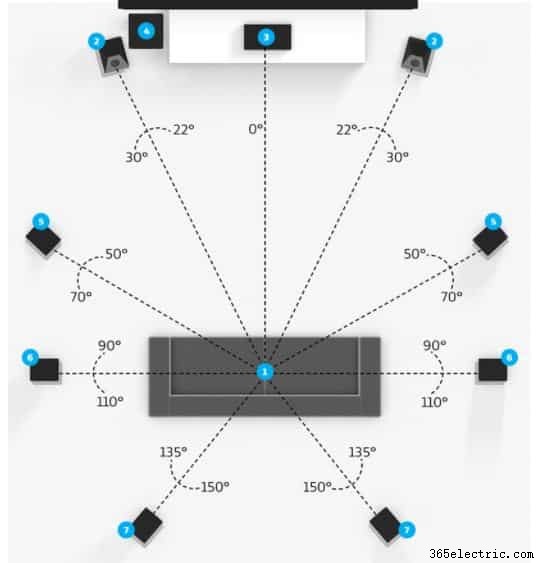
The left and right speakers provide an additional layer of sound to create that dome effect.
Here are the typical components:
| Item # | Description | Remarks |
| | | |
| 2 | Center Speaker | 1 set |
| 3 | Left / Right Speaker | 1 for each side (L/R) |
| 4 | Left / Right Front Wide Speaker | 1 for each side (L/R) |
| 5 | Left / Right Surround Speaker | 1 for each side (L/R) |
| 6 | Left / Right Back Speaker | 1 for each side (L/R) |
| 7 | Left / Right Ceiling Speaker | 1 for each side (L/R) |
| 8 | Subwoofer | 1 set |
10.2 Home Theater Surround Sound System
The hard-hitting 10.2 home theater surround sound system is a full-blown, professional and advanced home theater system for high-end home theaters.
This one is for the most advanced home theater professionals who are seeking the highest fidelity in home theater setups.
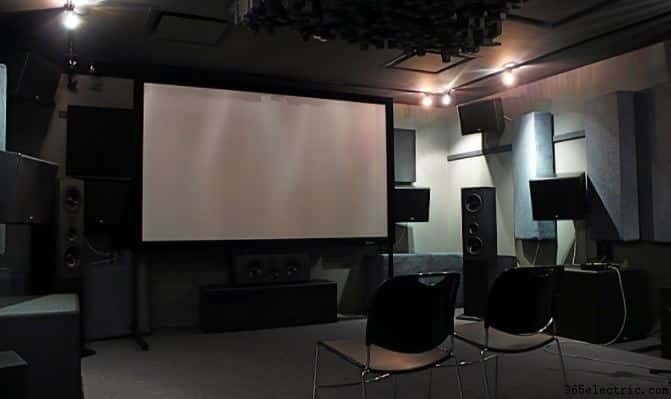
The 10.2 configuration includes 14 discrete channels if the left and right point surround channels are included.
The 10.2 system was in fact built by the developers of THX, the high fidelity audio/visual reproduction standards for movie theaters.
This configuration includes seven front channels:left and right wide speakers, left and right height speakers, left and right front speakers, and a center front speaker.
There are three surround speakers, including one left, one back, and one right, and two subwoofers.
10.2 Surround Sound System Setup
The 10.2 system is of course not typical and so only a few, dedicated devices are currently sold to accommodate this configuration.
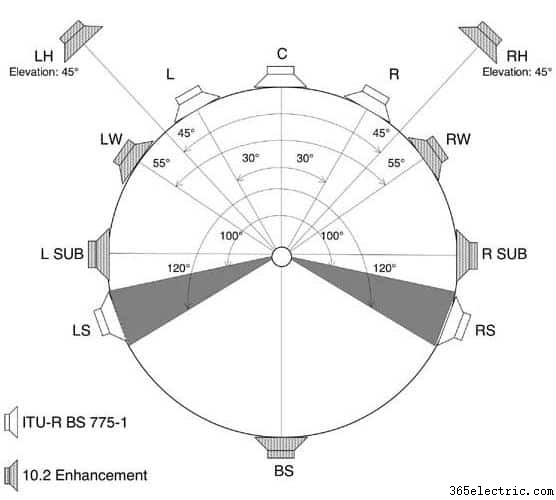
Aqui está a configuração típica:
- Seven front channels: Left Wide, Left Height, Left, Center, Right, Right Height, Right Wide
- Three surround channels: Left Surround, Back Surround, Right Surround
- Two LFE channels: LFE Left and LFE Right
12.2 Home Theater Surround Sound System
The 12.2 home theater system is rather similar to the 10.2 setup except that the 12.2 augments the LS (left surround) and RS (right surround) channels by two-point surround channels.
This way, the overall sound can be better manipulated and controlled by the system because the mixer will be allowed to shift sounds in a distinct 360° circle around the movie watcher.
These additional speakers may be referred to as “point surround” or “diffuse surround” channels.
12.2 Surround Sound System Setup
These point surround speakers are normally placed at the same angles as the standard surround speakers at +/-120 degrees. As already mentioned, these speakers are made into diffuse radiators using dipole speakers.
Here is the setup with point surround channels:
- Five front speakers: Left Wide, Left, Center, Right and Right Wide
- Five surround channels: Left Surround Diffuse, Left Surround Direct, Back Surround, Right Surround Diffuse and Right Surround Direct
- Two LFE channels: LFE Left, LFE Right (these are the subwoofers)
- Two Height channels: Left Height, Right Height
13.1 Home Theater Surround Sound and Beyond
The amazing 13.1 home theater surround sound system is one of the most complex home theater configurations out there.
As you might imagine, these setups are rather rare and you certainly won’t find them in a typical home theater system in a regular home. At this point, you are talking about high fidelity music rooms and theaters.
Higher Surround Sound Configurations
Dolby Digital Plus supports surround systems up to 13.1, and there are many other configurations for surround sound, like 12.2, 22.2, and more.
While these surround sound setups are fascinating and complex, they are a rare find in a typical home theater. However, they are fun to research and learn about, and there’s nothing wrong with dreaming of the possibilities!
Do You Need a Professional To Install Your Surround Sound System?
For simple setups such as the 3.1, 5.1 or even 7.2 home theater systems, you can surely go about that kind of setup yourself.
However, for the more complex configurations like the 9.1 or 10.2, you certainly need professional installers who have experience with things like overhead speakers and room acoustics.
Please be reminded that just purchasing a complex home theater surround system doesn’t mean or guarantee the best experience unless the room is set up professionally considering its own unique acoustics.
Consider Dolby Atmos
Many of these systems are Dolby Atmos compatible or based on the setup require Dolby Atmos speakers. If you want to create a cinematic experience, it’s not as good as RPX, but its the best you’ll get to in your house.
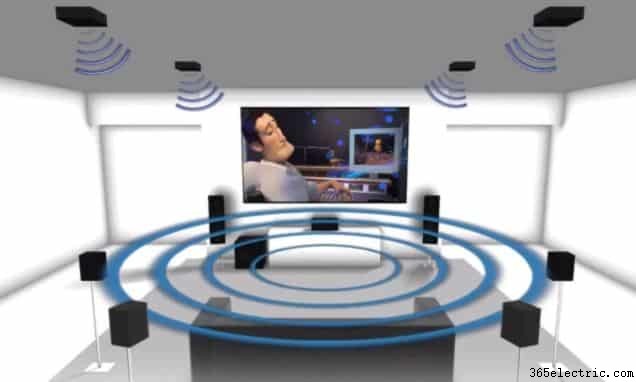
Dolby Atmos is a surround sound technology that creates a fuller cinematic experiencing which is high quality and highly realistic.
However, not all devices including receivers and amplifiers are compatible with Dolby Atmos. Before you go out and buy Dolby speakers, make sure your current devices are compatible. In addition, not all system,s support Dolby. For example, YouTube does not support Dolby audio. In fact, youtube does not support surround sound. For more information, read our article where we explore the question – does youtube support surround sound.
What Is The Best Number of Home Theater Channels
You may be surprised to learn that there is no magic number for how many speaker channels you should use. This is why we have so many different configurations.
The best options in terms of channels for you will depend solely on your room’s configurations including its size, shape, furniture, whether your home theater is soundproof or not, and many other considerations.
However, there are a number of rules of thumb to consider. For example, if your home theater is small, then you’ll want to go with a smaller number of speaker channels.
If you are having issues with your surround system where one or more speakers are not working, please check out our guide on how to make all speakers work on surround sound.
Surround Sound and Streaming Services
Today, many people get their content from streaming services like Netflix. While Netflix does support surround sound, not all content is compatible with surround sound.
For more information on how to determine if your Netflix title is compatible with surround sound and how to get Netflix to play through surround sound check out this guide.
What Does Each Channel In A Surround Sound System Do?
The audio signals connected to a surround sound system is divided through the different channels, which are then fed to the various speakers to be reproduced in specified frequencies such that the same sound is reproduced through the speakers in different ways.
Depending on the effect intended, emphasis on the sound quality will vary according to the channel it is fed into as dictated by the frequency settings on that speaker.
What Is The Difference Between 5.1 Channel And 2.1 Channel?
The bigger a soundbar is, the more channels it has. While a 2.1 channel soundbar has just two channels (one on either side) and a subwoofer, a 5.1 channel soundbar has two side speakers, a center channel and two extra speakers in the back which are either built-in or external.
What Is The Difference Between 3.1 Channel And 5.1 Channel?
Soundbars with 3.1 channel contain a channel more than the 2.1 soundbars, a center channel for better, clearer speech and background sound effects.
5.1 Soundbars come with an external subwoofer and five other channels –two side channels, one center, one surround left, and one surround right channels.
How Far Away Should Surround Speakers Be?
It is recommended that the front speakers be at least three feet away from the center speaker (which should be aligned with the TV) on either side, facing the audience. They should also be at least 6 feet back from the viewers.
Conclusão
Surround sound channels can seem rather confusing at first with all the numbers and strange terminology. However, once you know what you are really looking at, you will find that it is quite simple really.

















 Height speakers are additional surround sound speakers that are normally placed on the ceiling at the front of the home theater.These speakers add the dimension of height to the surround sound field to create a three-dimensional effect. So the 7.1.2 speaker system configuration is simply the 7.1 speaker system with 7 speakers and a subwoofer.The system includes the addition of two height speakers which are normally ceiling speakers or up-ward firing Dolby Atmos speakers.
Height speakers are additional surround sound speakers that are normally placed on the ceiling at the front of the home theater.These speakers add the dimension of height to the surround sound field to create a three-dimensional effect. So the 7.1.2 speaker system configuration is simply the 7.1 speaker system with 7 speakers and a subwoofer.The system includes the addition of two height speakers which are normally ceiling speakers or up-ward firing Dolby Atmos speakers.  You will find this setup mostly for Dolby Atmos in-ceiling speakers. Dolby Atmos is a surround sound technology that adds the height dimensions to surround sound systems to create that 3D effect in the surround sound field. This type of configuration is for more high-end home theaters as it takes a bit more work and is certainly more expensive than the simpler configurations. However, it’s worth the money because all these speakers work together to provides a top-notch, realistic, and immersive home theater cinematic experience.
You will find this setup mostly for Dolby Atmos in-ceiling speakers. Dolby Atmos is a surround sound technology that adds the height dimensions to surround sound systems to create that 3D effect in the surround sound field. This type of configuration is for more high-end home theaters as it takes a bit more work and is certainly more expensive than the simpler configurations. However, it’s worth the money because all these speakers work together to provides a top-notch, realistic, and immersive home theater cinematic experience. 








